Olympus Zuiko 40-150mm f/3.5-4.5
Designed and built specifically for the four-thirds standard Olympus cameras which have a crop factor of 2x, this lens is the approximate equivalent of the group of 55-200mm lenses that are made for the aps-c sensors of the majority of digital SLR’s. We take a look at how it performs.
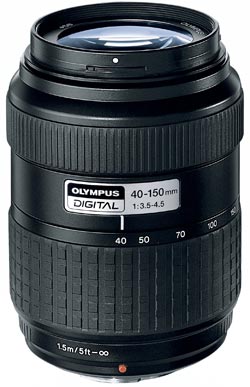 Specification
Specification
- Focal Length 40-150mm
- Construction 13/10 elements/groups
- Max aperture f/3.5-4.5
- Angle of view 30-8.2º
- Closest focus 1.5m
- Filter thread 58mm
- Dimensions 77x107mm
- Weight 0.425kg
- Hood yes (supplied)
- Price £199.99
Build and Handling
Despite the smaller sensor size of the four-thirds system, this lens is both bigger and heavier than all of it’s aps-c competitors and sports a larger front element carrying a 58mm filter thread. The lens mount itself is, however, a metal one that has a positive feel as it clicks home. The lens has no switch gear attached, with the change from manual to autofocus or a combination of the two being achieved through the camera menus.
The zoom ring is some 35mm deep and covered for the most part in a shallow ribbed rubber sleeve and leaving just enough room for the markings of 40, 50, 70, 100 and 150mm. A nameplate sits between this and the Manual focus ring and there is no attempt at a distance scale. The manual focus rng is the widest part of the lens with a 15mm ribbed section before dropping in diameter down to the front element. This ring has the same torque whatever mode is employed for it’s use and in manual mode requires almost one and a half turns to cover the focus range. The closest focus distance of 1.5m is a little disappointing and Olympus recommend the use of extension tubes in the enclosed leaflet.
Zooming to the longest focal length extends the front of the lens some 36mm and reveals an untidy but sturdy looking flange around the front element onto which the supplied cup shaped hood fits with a bayonet system. There is a click as it locks, but this is a little soft and less than reassuring that it will stay there. Focussing to the closest point extends the front a further 12mm. With the camera turned off, the manual focus ring is inoperable, indicating that the ring is just an adjuster for the AF motor rather than a genuine mechanical focus ring.
Optical Quality
As with all zoom lenses, the optical results vary throughout the focal length range, invariably better at the shorter end than the long end. This is the case with this lens, although the difference is not as marked as some we have tested. Distortion starts with a slight (0.53%) barrel effect at the short, 40mm length and turns to a mild (1.08%) pincushion effect at the 150mm mark. Neither end exceeds the 1.5% at which the effect would become visible to the naked eye.
The straightening of the optical path that is attempted with these lenses designed for the four-thirds system helps with the control of chromatic aberrations and there were no obvious nasties in this department. Contrast and colour are well recorded with the coatings rendering no unnatural casts.
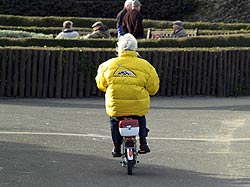 The AF system is quick enough to have caught this motorised moped but would struggle with racing cars. Set at 141mm and shot at 1/125sec at f/9. ISO200 |  A Beach scene in March! 1/500sec at f/8 and ISO200. Lens set at 92mm |
 | Set at 57mm on this 2x crop sensor gives an ideal portrait perspective. 1/100sec at f/8 and ISO100 |
Click on each comparision photo below to view full size versions
Below is our lens test data. To find out how to use these graphs look at this article: How we test lenses
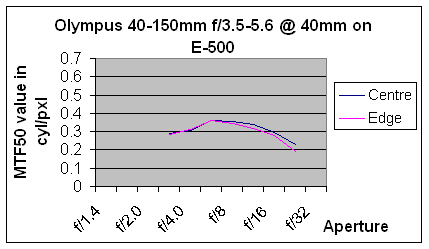
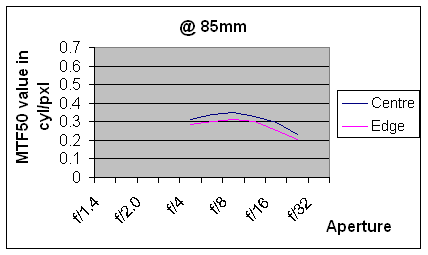
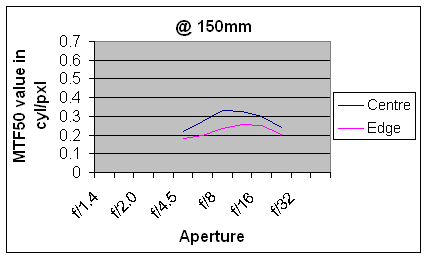
Verdict
With modern lenses, even the cheaper ones, producing results that could only have been dreamed about a decade or two ago, this model from Olympus, although no slouch, is not that outstanding. The somewhat quirky method of manual focussing may well suit some, but having to delve into menus to switch it over and the large amount of movement required to get from one end of the range to the other gives the impression that it is designed for tweaking the automatic system rather than operating as a stand alone system. However, with more interest being shown in the four-thirds system of late, this offering stands as a good second lens and a target for newer models to beat.
In summary, the positive points of the Olympus Zuiko 40-150 f/3.5-4.5 are:
![]() Good build quality for class
Good build quality for class
![]() Good control of optical nasties
Good control of optical nasties
![]() Metal mount
Metal mount
The negative points are:
![]() AF a little noisy
AF a little noisy
![]() Quirky manual focus method
Quirky manual focus method
![]() Size and weight larger than APS-C opposition.
Size and weight larger than APS-C opposition.
Check out the latest price for the Olympus Zuiko 40-150 f/3.5-4.5 here
Test by Ian Andrews www.wildaboutkent.co.uk
Add your message
Please login here or if you've not registered, you can register here. Registering is safe, quick and free.
photodo Stats
428 MTF tests
74 in-depth photodo reviews
100+ users join each day
Help the lens community by reviewing or rating a lens today via our lens search
Latest Lens Reviews
- Chinon 28mm f/2.8 Vintage Lens Review
- Canon EF 70-200mm f/4L IS II USM Lens Review
- Samyang AF 85mm f/1.4 EF Review
- Sigma 70mm f/2.8 DG Macro Art Review
- Samyang AF 24mm f/2.8 FE Review
- Meike 50mm f/1.7 Review
- Tamron 70-210mm f/4 Di VC USD Review
- Lensbaby Burnside 35mm f/2.8 Review
- Asahi Super Takumar 50mm f/1.4 Review
- Asahi Super-Multi-Coated Takumar 135mm f/3.5 Review




